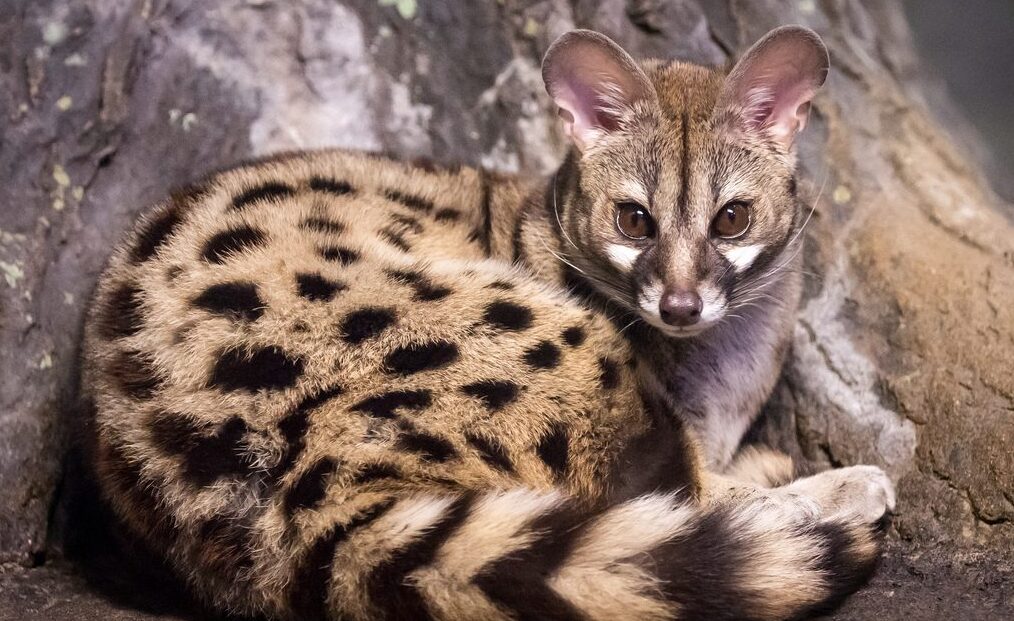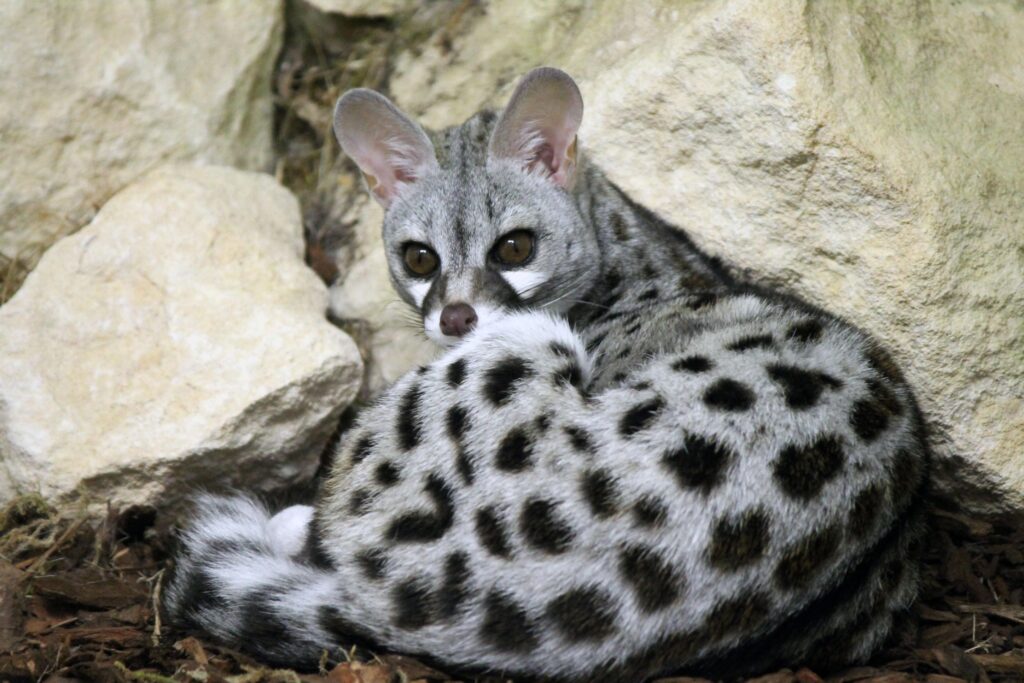Table of Contents
ToggleIntroduction

Genets are small to medium-sized carnivorous mammals belonging to the family Viverridae. They are known for their sleek appearance, distinct coat patterns, and nocturnal behavior. Genets are primarily found in Africa, Europe, and parts of Asia. They have adapted to various habitats, including forests, grasslands, and urban environments.
Genets have slender bodies, a pointed snout, and large ears. Their most distinctive feature is their coat, which can vary in color and pattern. Genets often have a spotted or striped coat, which aids in camouflage. These markings can vary significantly between species and even within populations. Their tails are usually long and bushy, helping them maintain balance as they move through trees and other terrain.
Physical Characteristics
Size and Weight
Genets are generally small to medium-sized carnivorous mammals, varying their size and weight among different species and geographic regions. On average, genets measure around 40 to 55 centimeters (16 to 22 inches) in body length, with an additional tail length of about 40 to 55 centimeters. However, some larger species can reach up to 90 centimeters (35 inches) in total length.
Genets typically range in weight from 1 to 3 kilograms (2.2 to 6.6 pounds), although this can vary depending on the species and individual conditions. Generally, females tend to be slightly smaller than males.
Fur and Coloration
The fur of genets is one of their most distinctive features, with various species displaying different coat patterns and colorations. Genet fur is generally soft and sleek, which aids in their movement through multiple habitats, including trees and underbrush. The fur also helps with insulation during cooler nights.
Coat patterns can include spots, stripes, and a combination of both. These markings are often irregular, contributing to the genet’s camouflage in its natural environment. The coloration of genet fur varies widely between species and can range from shades of brown, gray, black, and even reddish tones. Some species have a lighter background with darker spots or stripes, while others have a more uniform coloration.
Body Structure And Adaptations
Limbs and Tail: Genets have well-adapted limbs for climbing and terrestrial movement. Their limbs are relatively long and equipped with sharp, retractable claws that help them grip onto trees and other surfaces. This is particularly important since many genet species are arboreal, spending a significant amount of time in trees. Their long, bushy tails aid in maintaining balance while navigating through branches and other terrain.
Nocturnal Adaptations: Genets are primarily nocturnal creatures, which means they are most active during the night. Their large eyes are adapted for low light conditions, and they have a reflective layer behind the retina called the tapetum lucidum. This structure enhances their night vision by reflecting light through the retina, allowing them to see better in dim lighting.
Carnivorous Diet: Genets are carnivores, and their teeth are adapted for a diet consisting of various prey, including insects, small rodents, birds, and even fruits. They have sharp, pointed teeth for capturing and consuming their prey.
Scent Marking: Genets have scent glands near their anus and perineal area. These glands secrete a musky odor for marking territory and communicating with other genets. Scent marking plays a crucial role in social interactions and mating behaviors.
Genet – Habitat And Distribution
Natural Habitats
Genets are adaptable creatures that inhabit diverse natural habitats, including forests, grasslands, savannas, woodlands, and even urban environments. Their ability to thrive in different ecosystems is partly due to their versatile behaviors and physical adaptations.
Genets may be more arboreal (tree-dwelling) or terrestrial (ground-dwelling), depending on the species. This adaptability allows them to exploit various food sources and find suitable shelter.
Geographic Distribution
Genets are found in various regions across Africa, Europe, and Asia. While their distribution is not uniform across these continents, they have established populations in diverse geographic areas. Some of the more well-known genet species and their distributions include:
- Common Genet (Genetta genetta): Found in southern Europe, North Africa, and parts of the Middle East.
- Small-spotted Genet (Genetta genetta): Primarily distributed throughout sub-Saharan Africa.
- Large-spotted Genet (Genetta tigrina): Native to central and western Africa.
- Cape Genet (Genetta tigrina): Native to southern Africa.
- Abyssinian Genet (Genetta abyssinica): Found in East Africa, including parts of Ethiopia and Sudan.
These are just a few examples, and several other species have specific distributions. Genets have adapted to various climates and habitats within these regions, ranging from tropical rainforests to arid savannas.
Ecological Significance
Genets play several vital roles within their ecosystems:
Predator-Prey Dynamics: As carnivores, genets help control populations of their prey species, such as rodents and insects. This can have cascading effects on the entire food web, influencing the abundance and behavior of other species.
Seed Dispersal: Some genet species consume fruits as part of their diet. By consuming fruits and then moving around, they contribute to seed dispersal, which aids in plant regeneration and maintaining biodiversity.
Scavengers: Genets may scavenge on carrion, helping to clean up dead animal matter and preventing the spread of disease.
Pollination: While not their primary role, genets may contribute to pollination by transferring pollen from one flower to another while feeding on nectar.
Indicator Species: The presence and abundance of genets can serve as indicators of the health of their ecosystems. Changes in their populations might reflect shifts in habitat quality or environmental conditions.
Hunting Techniques Of Genet
Genets employ various hunting techniques to catch their prey. Some of the standard techniques include:
Ambush Predation: Genets are known to patiently wait and stalk their prey, using their agility and camouflage to their advantage. They often blend into their surroundings and pounce on unsuspecting prey when it comes within striking distance.
Climbing: Genets are excellent climbers, and they often use their climbing abilities to access prey that might be hiding in trees, shrubs, or other elevated locations.
Nocturnal Behavior: Genets are primarily nocturnal animals, which means they are most active during the night. Their heightened senses and adaptations, such as keen night vision and sharp hearing, help them locate and capture prey in low-light conditions.
Opportunistic Foraging: Genets are adaptable and opportunistic in their feeding behavior. They will exploit various food sources based on what is available in their environment. This might include scavenging from carcasses or raiding bird nests for eggs.
Adaptations And Survival Strategies Of Genets
1. Nocturnal Behavior and Camouflage
Genets are primarily active at night, a behavior known as nocturnality. This adaptation helps them avoid daytime predators and competition. Their fur coat often features patterns and colors that blend into their surroundings, providing effective camouflage in their habitat.
2. Climbing Abilities
Genets possess sharp claws and flexible bodies, making them skilled climbers. This adaptation allows them to access food in trees, escape ground predators, and find shelter in elevated locations.
3. Keen Senses
Genets have evolved excellent night vision and acute hearing, enhancing their ability to hunt and navigate in low-light conditions. These heightened senses give them an advantage in detecting prey and avoiding danger.
4. Varied Diet and Opportunistic Feeding
Genets are adaptable in their diet, consuming insects, small mammals, birds, and fruits. This adaptability ensures they can find food even when certain prey items are scarce, increasing their chances of survival.
5. Camouflage and Markings
The coat patterns of genets not only provide camouflage but also serve as unique markings for individual identification. This adaptation can aid in communication, mate selection, and territorial marking.
6. Agile Hunting Techniques
Genets employ stalking, pouncing, and ambush techniques to capture prey. Their agility and quick reflexes enable them to catch fast-moving insects and small animals.
7. Territorial Behavior
Genets are known to establish and defend territories. This adaptation helps ensure a consistent food supply and reduces competition with other individuals.
8. Scent Marking and Communication
Genets use scent glands to mark their territory and communicate with other genets. This adaptation minimizes conflicts and helps them establish dominance without confrontations.
9. Solitary Lifestyle
Genets often lead solitary lives, reducing competition for resources within their territory. This behavior ensures they have sufficient access to food and shelter.
10. Reproductive Strategies
Genets have adapted to reproduce with relatively short gestation periods multiple times a year. This strategy increases their chances of passing on their genes and maintaining their population, even in challenging environments.
Conclusion
The Genet, a member of the Viverridae family, stands as a remarkable example of nature’s ingenuity in adapting to diverse environments. Through a range of specialized traits and behaviors, the genet has secured its place in various ecosystems. From its nocturnal habits and agile climbing abilities to its keen senses and opportunistic diet, the genet has crafted an intricate survival toolkit.
Its unique coat patterns and communication methods further exemplify its ability to thrive in complex social and territorial dynamics. The genet’s solitary lifestyle, rapid maturation, and reproductive strategies underscore its resilience in environmental challenges. This small carnivorous mammal is a testament to the intricate interplay between adaptation, survival, and the complex tapestry of life’s diversity on our planet.







